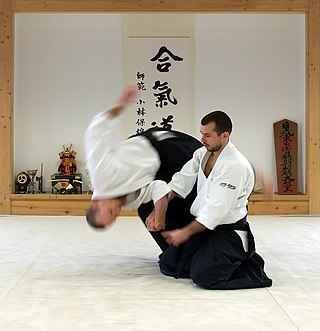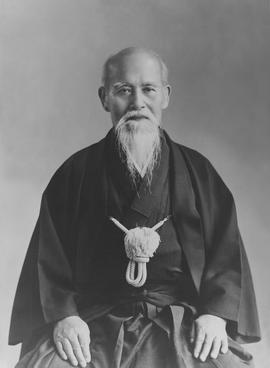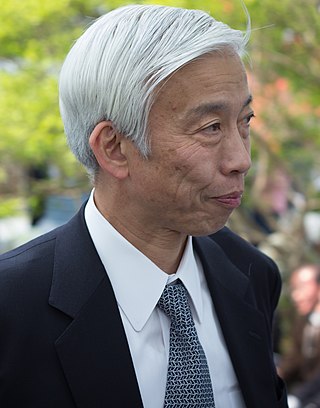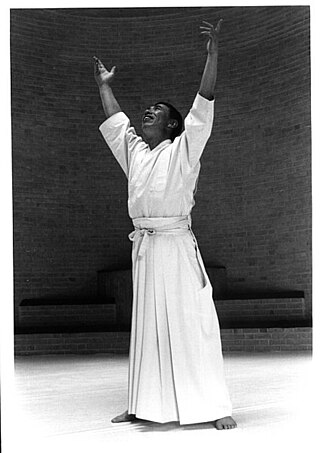Related Research Articles

Aikido is a modern Japanese martial art that is split into many different styles, including Iwama Ryu, Iwama Shin Shin Aiki Shuren Kai, Shodokan Aikido, Yoshinkan, Renshinkai, Aikikai and Ki Aikido. Aikido is now practiced in around 140 countries. It was originally developed by Morihei Ueshiba, as a synthesis of his martial studies, philosophy and religious beliefs. Ueshiba's goal was to create an art that practitioners could use to defend themselves while also protecting their attackers from injury. Aikido is often translated as "the way of unifying (with) life energy" or as "the way of harmonious spirit". According to the founder's philosophy, the primary goal in the practice of aikido is to overcome oneself instead of cultivating violence or aggressiveness. Morihei Ueshiba used the phrase masakatsu agatsu katsuhayabi" to refer to this principle.

Morihei Ueshiba was a Japanese martial artist and founder of the martial art of aikido. He is often referred to as "the founder" Kaiso (開祖) or Ōsensei (大先生/翁先生), "Great Teacher".

The Aikikai is the original school of Aikido. It is centered on the Aikikai Foundation in Japan, and its figurehead is the Doshu. It is represented globally through the International Aikido Federation.

Moriteru Ueshiba is a Japanese master of aikido. He is a grandson of Morihei Ueshiba, founder of aikido, and son of Kisshomaru Ueshiba. Ueshiba is the third and current Doshu of the Aikikai.
Morihiro Saito was a teacher of the Japanese martial art of aikido, with many students around the world. Saito's practice of aikido spanned 56 years, from the age of 18, when he first met aikido founder Morihei Ueshiba, until his death in 2002.
Iwama-style Aikido(岩間合気道) is the style of aikido that was taught in Iwama by the founder of aikido, Morihei Ueshiba, and especially the lineage passed on through Morihiro Saito, a close disciple who was given responsibility over Iwama dojo by Ueshiba.
The Iwama Dōjō is a dōjō built by the founder of aikido, Morihei Ueshiba, who lived there from 1942 until his death in 1969. It is located in the former town of Iwama and became an important historical location for the development of aikido and "a Mecca to the aikido community." This dojo is also where Morihiro Saito, one of the founder's closest students, learned and taught aikido from 1946 until 2002 developing what is often referred to as the Iwama Style.
Gozo Shioda was a Japanese master of aikido who founded the Yoshinkan style of aikido. He was one of aikido founder Morihei Ueshiba's most senior students. Shioda held the rank of 10th dan in aikido.
Ueshiba is a Japanese surname. Notable people with the surname include:
Akira Tohei was a Japanese aikido teacher. He held the rank of 8th dan in the Aikikai.

Masamichi Noro is the founder of Kinomichi and was an uchi-deshi of Morihei Ueshiba, the founder of Aikido.
Kisaburo Osawa was an influential aikido teacher who taught for many years at the Aikikai Hombu Dojo and was a close advisor to Kisshomaru Ueshiba.
Though the art of aikido is characteristically different from other Japanese martial arts, it has a variety of identifiable styles within the family of organizations descending from the teachings of Morihei Ueshiba.
Mitsuteru Ueshiba is the son of the current Aikido Dōshu, Moriteru Ueshiba. In keeping with the iemoto system, he is expected to succeed his father as Dōshu. He is the great-grandson of Morihei Ueshiba, the Aikido founder.

Hiroshi Isoyama is a Japanese teacher of the martial art of aikido. He began training in the Iwama Dojo at the age of 12 as a direct student of the founder of aikido, Morihei Ueshiba in June 1949. He currently holds the rank of 8th dan shihan in the Aikikai and is that organization's Technical Councillor. Isoyama was made the acting head of the Iwama dojo on behalf of Ueshiba Moriteru following the passing of Morihiro Saito. He currently remains as Executive Advisor and senior instructor of that dojo.
Yutaka Kurita was one of the last live-in students (uchideshi) of the founder of aikido, Morihei Ueshiba. He entered the Aikikai Hombu Dojo in 1956 and after a year as a regular aikido student was accepted as an uchideshi by Ueshiba and went with him to live, work and train at the Iwama dojo. He received his 3rd dan (sandan) directly from Ueshiba and served him as his assistant/attendant, scribe, uke, and assisted in instructing when people came from Tokyo to Iwama to study aikido.

International Aikido Federation is a world governing body for the sport of Aikido.
Iwama was a small town located in Nishiibaraki District, Ibaraki Prefecture, Japan.

Stanley A. Pranin was an American martial artist, founding publisher, and editor-in-chief of Aikido Journal. Pranin, a researcher and archivist of aikido, has written and published several books and many articles about aikido, Daito-ryu Aikijujutsu, and Morihei Ueshiba and was an influential figure in the aikido world.
References
- 1 2 3 4 5 6 7 8 9 Pranin, S. A. (c. 2009): Encyclopedia of Aikido: Ueshiba, Kisshomaru Archived 2011-06-05 at the Wayback Machine Retrieved on March 1, 2010.
- 1 2 3 4 5 Goldsbury, P. (1999): Obituary: Doshu Kisshomaru Ueshiba Archived 2011-07-24 at the Wayback Machine Retrieved on March 2, 2010.
- 1 2 3 Aikikai Foundation: Doshu chronology Archived 2009-10-01 at the Wayback Machine Retrieved on February 28, 2010.
- ↑ Dang, P. T., & Seiser, L. (2006): Advanced Aikido (p. 3). Tokyo: Tuttle. ( ISBN 978-0-8048-3785-9)
- ↑ Pranin, S. A. (1993): Morihei Ueshiba & Kisshomaru Ueshiba Archived 2017-11-07 at the Wayback Machine Retrieved on March 11, 2010.
- ↑ Pranin, S. A. (1999): Interview with Moriteru Ueshiba Archived 2010-12-04 at the Wayback Machine Retrieved on February 28, 2010.
- ↑ Dang, P. T., & Seiser, L. (2003): Aikido basics (p. 22). Boston, MA: Tuttle. ( ISBN 978-0-8048-3490-2)
- ↑ Obituary - Doshu Kisshomaru Archived 2017-10-21 at the Wayback Machine Written by Peter Goldsbury, 1 February 1999